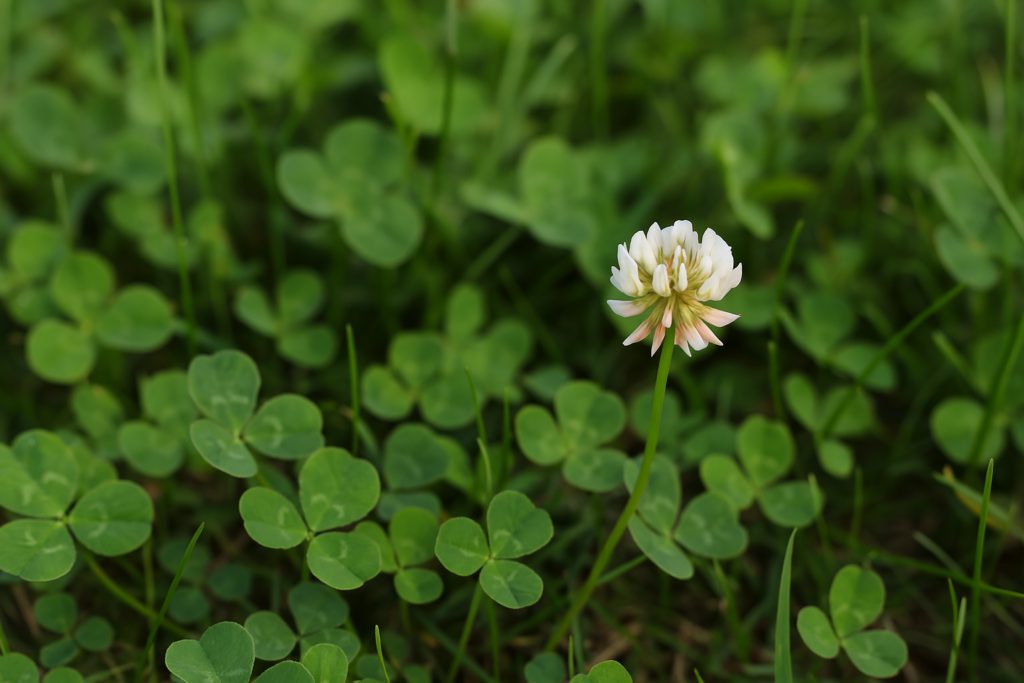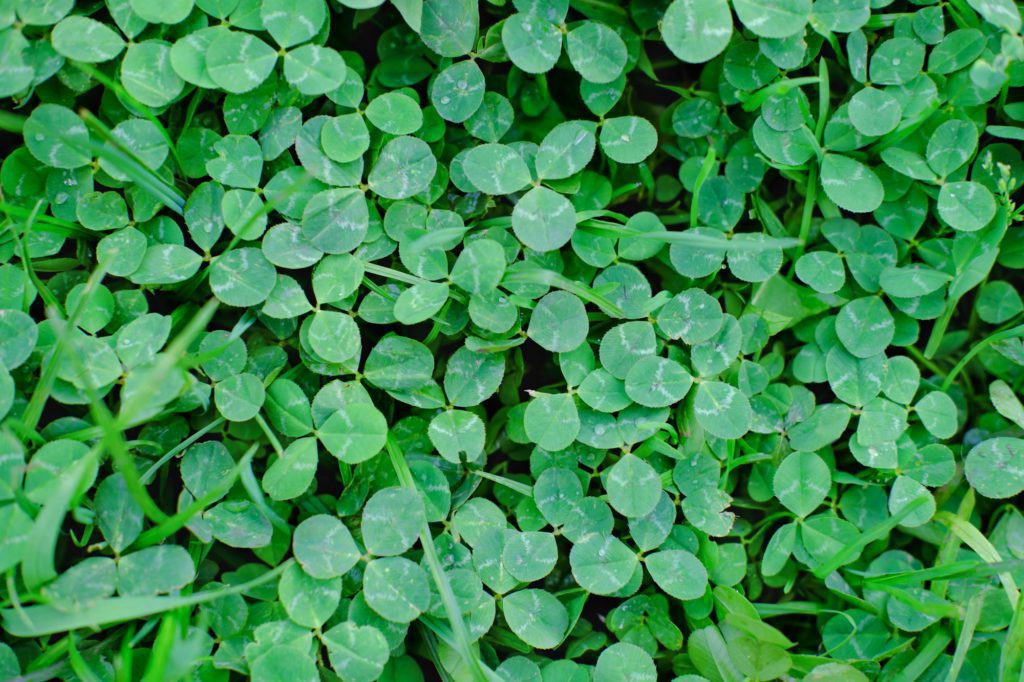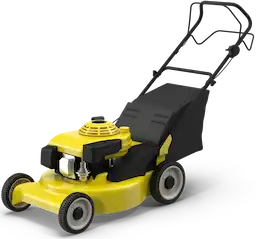Choosing clover over grass transforms your lawn into an eco-friendly paradise. It’s drought-resistant, needing just half an inch of water weekly, and you’ll mow only a handful of times each year. Plus, clover naturally enriches the soil with nitrogen, eliminating the need for fertilizers. Say goodbye to brown spots from pets and hello to vibrant biodiversity, as clover invites pollinators and beneficial insects. If you value sustainability and low-maintenance beauty, clover is your answer. Ready to enjoy thriving greenery and a healthier ecosystem for both you and nature? There’s much more to uncover about this worthwhile shift.
What Is a Clover Lawn?

Imagine transforming your yard into a lush, eco-friendly oasis with a clover lawn—an ideal ground cover that’s both beautiful and sustainable.
By choosing clover, especially resilient varieties like white clover, you embrace a low-maintenance solution that nourishes the soil and supports local wildlife.
Say goodbye to constant watering and chemical fertilizers, and hello to a vibrant, pet-friendly lawn that thrives naturally.
Understanding Clover as Ground Cover
While many homeowners are familiar with traditional grass lawns, embracing a clover lawn can truly elevate your outdoor space.
Clover, as a ground cover, creates a lush, inviting green carpet that flourishes in diverse climates. Its nitrogen-fixing properties enrich the soil, significantly reducing the need for fertilizers.
With minimal maintenance, less watering, and natural weed suppression, clover is an eco-friendly, cost-effective choice for a vibrant, welcoming lawn you’ll adore.
Types of Clover for Lawns

When considering a clover lawn, you’ll discover several types of clover that offer unique benefits for your outdoor space.
White clover, with its low-growing habit and charming white flowers, stands out as a popular choice.
For added diversity and resilience, consider mixing in microclover for a dense, adaptable lawn.
Each clover type enhances soil health, attracts pollinators, and helps create a thriving, eco-friendly environment.
9 Reasons to Choose Clover Instead of Grass
Opting for clover over traditional grass is a smart move for both sustainability and convenience.
You’ll use less water, mow far less often, and naturally enrich your soil—all while saving time and money.
Plus, clover supports pollinators and thrives in shady spots, offering a vibrant green lawn that stays lush through the hottest months.
1. Clover Needs Less Water Than Grass
If you’re seeking a vibrant, sustainable alternative to traditional grass, clover is the game-changer your lawn needs.
Clover requires significantly less water, consuming only about 0.5 inches per week. Its deep roots tap into lower soil moisture, making it drought-resistant.
- Lower water bills
- Conserves essential resources
- Thrives in poor soil
- Reduces irrigation needs
- Enhances soil health
2. Clover Requires Less Frequent Mowing
Imagine a lawn that demands less of your time and effort while still looking lush and vibrant.
Clover typically needs mowing just 4-6 times a year, compared to the weekly upkeep of traditional grass. Its dense growth also suppresses weeds, minimizing mowing needs.
With clover, your lawn stays green and full, even through summer heat, creating a beautiful space without the constant maintenance.
Choose clover for effortless beauty.
3. Clover Enriches the Soil Naturally
Choosing clover instead of grass means opting for a natural way to improve your soil’s health.
Clover enriches the soil by fixing nitrogen, eliminating the need for synthetic fertilizers. Its deep roots also improve soil structure and boost moisture retention, supporting a vibrant ecosystem.
- Nitrogen-fixing abilities
- Improves soil aeration
- Increases organic matter
- Suppresses weeds naturally
- Prevents soil erosion
4. Clover Supports Pollinators and Beneficial Insects
While traditional grass lawns might look appealing, clover offers a major ecological advantage by supporting pollinators and beneficial insects.
Clover attracts creatures like ladybugs and lacewings, which help control pests naturally. Its long blooming period provides essential food for pollinators like honeybees and butterflies, promoting biodiversity.
Welcome clover, and transform your lawn into a vibrant, sustainable ecosystem.
5. Clover Tolerates Shade Better Than Most Grasses
If you’re hoping for a lush, green lawn in shaded areas, clover is your go-to solution. Its resilience in low-light conditions makes it ideal for spots where many traditional grasses struggle.
Adopt clover for your lawn, and enjoy these benefits:
- Thrives with minimal sunlight
- Deep root system for better nutrient access
- Reduces fertilizer needs
- Maintains vibrant green color
- Sustainable and eco-friendly choice
6. Clover Is Pet-Friendly and Prevents Brown Spots
Choosing clover over traditional grass is a smart move, especially if you have pets.
Clover is pet-friendly, allowing your furry friends to frolic safely without exposure to toxic chemicals. Unlike grass, clover resists those unsightly brown spots caused by dog urine, keeping your yard lush and green.
Its dense growth provides a soft, welcoming surface for pets to enjoy, creating a harmonious outdoor space for everyone.
7. Clover Requires No Fertilizer or Herbicides
Beyond being pet-friendly, clover delivers an outstanding advantage for any environmentally conscious homeowner: it requires no fertilizers or herbicides.
Imagine a lawn that nurtures itself and protects the planet. Here’s why clover is the perfect choice:
- Naturally enriches soil without synthetic fertilizers
- Suppresses weeds, reducing the need for herbicides
- Thrives in nitrogen-poor soils
- Attracts beneficial insects, boosting biodiversity
- Creates a self-sustaining ecosystem
8. Clover Is Cost-Effective and Easy to Seed
While traditional grass lawns might seem like the standard, clover offers a smart, budget-friendly alternative that’s gentle on your wallet and the environment.
Clover seed costs about $1 per 1,000 square feet, making it an affordable option. It’s easy to seed and establishes quickly, germinating in just 7 to 21 days.
Plus, clover’s low-maintenance nature saves time and money on watering and mowing.
9. Clover Provides a Soft, Lush Lawn Aesthetic
Choosing clover isn’t just a financial win—it also transforms your lawn into a lush, inviting space.
A clover lawn offers a soft surface that’s perfect for walking, playing, or simply relaxing. It stays vibrant year-round, even during drought conditions.
Enjoy these benefits:
- Dense, lush appearance
- Comfortable for activities
- Attracts pollinators
- Consistent green color
- Complements diverse landscapes
What to Know Before Considering a Clover Lawn
Before making the switch to a clover lawn, it’s important to understand its growth preferences and potential drawbacks.
Clover thrives in sunny spots but may struggle in deep shade, so be sure to consider your yard’s light conditions.
While clover is excellent for lawns, it can spread into garden beds if not managed properly. It also needs reseeding every few years to maintain its lush, full appearance.
Does Clover Grow in Shade?
Curious whether clover can thrive in shaded areas? Clover does tolerate partial shade but truly shines in sunlit locations.
To help your clover lawn succeed in shaded spots, keep these tips in mind:
- White clover is one of the most shade-friendly options.
- Ensure at least 4-6 hours of sunlight per day.
- Consider mixing clover with shade-tolerant grasses.
- Monitor soil pH levels for optimal growth.
- Expect slower growth in densely shaded areas.
This blend creates a welcoming, lush environment even where sunlight is limited.
Will Clover Invade Garden Beds?
When planning a clover lawn, it’s smart to consider how clover might affect your garden beds. Clover can spread vigorously, rooting easily in a variety of soil types.
Without proper management, it may creep into garden spaces and compete with other plants. To maintain balance, control clover’s spread by establishing clear boundaries and mowing regularly along the edges.
Opting for microclover varieties can also help minimize this risk while still enjoying the benefits of clover throughout your lawn.
Disadvantages of Clover to Keep in Mind
While clover lawns offer many advantages, it’s important to be aware of a few potential drawbacks before diving in. Clover may not handle heavy foot traffic as well as some traditional turfgrasses, which could lead to wear in high-traffic areas.
Consider these factors:
- Requires reseeding every 2-3 years.
- Wet clover may stain clothing.
- Attracts bees, which could pose risks for those with sting allergies.
- Struggles in cold, arid climates.
- Offers limited durability compared to some grass varieties.
How to Plant a Clover Lawn (Or Mix Clover With Grass)
Transform your yard into a lush, eco-friendly oasis by choosing the right clover seed and following a few simple steps.
White clover is a top choice for its compatibility with grass and superior nitrogen-fixing abilities, helping your lawn stay vibrant and healthy.
Prepare your soil carefully, spread the seeds evenly, and maintain moisture during the germination phase to watch your clover lawn flourish with minimal effort.
Choosing the Right Clover Seed

Selecting the right clover seed is key to creating a lush, sustainable lawn. Consider these options to find the best fit for your yard:
- White clover: Rapid spreading for quick, reliable coverage.
- Microclover: Low-growing and blends well with traditional grass.
- Red clover: Taller variety with attractive blooms and health benefits.
- Seeding rate: Use 1/4 to 1/2 pound of seed per 1,000 square feet.
- Mixing options: Combine with tall fescue or Kentucky bluegrass for added texture and resilience.
Steps to Plant a Clover Yard Successfully
Ready to transform your yard into a lush clover haven? Follow these simple steps for planting success:
- Test your soil to ensure a pH between 6.0 and 7.0.
- Remove existing grass and weeds to reduce competition.
- Loosen the soil to create a welcoming environment for new seeds.
- Spread 1-2 pounds of clover seed per 1,000 square feet.
- Keep the area consistently moist until the seeds germinate and establish.
With the right preparation and care, your clover lawn will take root and thrive with minimal effort.
Clover Lawn Care Tips for Long-Term Success
To ensure your clover lawn stays healthy and vibrant, embrace nature’s simplicity with minimal mowing and a chemical-free approach.
Keep your mower set at a height of 3-4 inches, and plan to mow only 4-6 times a year to maintain a lush, well-kept look.
Skip the fertilizers—let clover’s natural nitrogen-fixing abilities do the work while you reduce your environmental footprint.
Mowing and Maintenance Guidelines
Clover lawns are famously low-maintenance, but understanding their specific care needs will help you enjoy long-term success.
Here are key tips for keeping your clover lawn thriving:
- Mow 4-6 times a year after the blooming period.
- Maintain a height of 3-4 inches for optimal health and appearance.
- Skip aeration—clover’s root system naturally keeps soil loose and healthy.
- Monitor and manually remove any persistent weeds.
- Reseed every 2-3 years to keep your lawn looking full and fresh.
Skip the Chemicals—Let Clover Thrive Naturally
Though it might seem counterintuitive, avoiding chemicals is the secret to maintaining a vibrant, sustainable clover lawn.
Clover’s dense growth helps suppress weeds, while its nitrogen-fixing roots enrich the soil—all without the need for synthetic fertilizers or harmful herbicides.
By letting clover do what it does best, you’ll enjoy a beautiful, eco-friendly lawn that takes care of itself.
Considering a Clover Lawn Instead of Grass? Let LawnGuru Help You Get Started!
Imagine stepping into a lush, green oasis that not only pleases the eye but also cares for the environment—and your wallet.
A clover lawn is your ticket to sustainable beauty. With its nitrogen-fixing power, drought resistance, and low-maintenance needs, clover offers a smart, eco-friendly alternative to traditional grass.
Let LawnGuru help you bring this vision to life. Our team can guide you through the process of creating a thriving clover lawn, offering:
- Minimal watering
- Low seeding costs
- Fewer mowings
- Pet-friendly solutions
- A boost in biodiversity
Ready to make the switch? Let LawnGuru show you how easy and rewarding it can be to grow a lawn that’s better for both you and the planet.


